If you’re looking to improve your chances of winning when betting on horses, then understanding pace in horse racing is something you should prioritize. While nothing quite compares to the thrill of live betting, it’s not as common in horse racing as it is in other sports because of how relatively quickly the races end.
Therefore, it’s best to prepare yourself well in advance when betting on horses. One way of going about this is by familiarizing yourself with some of the key horse racing terms and concepts, such as pace handicapping.
Let’s take a closer look at what pace handicapping is and what it entails below.
What is pace handicapping and why is it important for horses?
Horse racing handicappers will tell you that pace and speed are two of the most vital considerations if you’re looking to do well in horse racing. For this piece, we’ll focus on pace handicapping. Pace handicapping, not to be confused with speed handicapping, is the rate at which a horse runs a race, affecting the outcome.
Simply put, it is what helps the bettor determine which horse is likely to go early and which will stay fast late. This gives you an indication of how the race might turn out and, if done correctly, can help you determine if a particular horse has any advantage over its opponents and could likely win the race.
Understanding the different pace styles in horse racing

Horse race handicapping requires paying special attention to the different pace styles of the horses to gauge how they might compare to their opponents. Pace style refers to a horse’s way of running that has been witnessed over time. This is typically affected by things such as the horse’s pedigree, its mother and father’s running styles or how it was trained.
Pace styles can be categorized as one of the following three: front-runners, stalkers and closers.
Front-runners (also known as pace setters)
These horses set their intentions from the onset. They often get an early lead because they assume a high speed from the minute the race begins. Because of this, should it happen that they end up falling behind and being overtaken by a horse with another pace style, it’s unlikely that they’ll be able to attain their initial lead to win the race.
Stalkers
Stalkers adopt somewhat of a mixed approach to racing; they don’t go for an initial lead, but they aren’t the underdogs, either. Once the race starts, stalkers follow behind the front-runners and depend on the jockey’s timing and skill to determine when they should go all in.
Depending on how the race is playing out, this can be at any point in the race, based on the jockey’s discretion and ability to “read the room,” so to speak. Stalkers are flexible and adaptable, and if they pace themselves well, they won’t tire too soon in the race. Instead, they could push in the final stretch when victory is in sight.
Closers
Closers are the opposite of front-runners. They are the underdogs that conserve their energy and effort in the beginning, which may cause others to immediately rule them out of the race. However, closers can cover a lot of ground in a relatively short space of time. This means that toward the end of the race, when the front-runners and stalkers may tire, they can close in and potentially win the race.
How to spot the pace style of a racehorse

By studying thoroughbred speed and pace styles, you can identify certain patterns and behaviors that a particular horse has exhibited in past races. This can guide your thinking and decision-making on which horse to get behind.
Additionally, the running lines of a horse are also key indicators. The running line is the progression of a horse relative to the others. A running line indicates where the horse was at each stage of the race, as well as the distance in lengths relative to the front runner at a given point in time.
Where to find more information about track bias
Track bias in horse racing terms refers to when the track surface puts a certain running style at an advantage or disadvantage. When handicapping horses, you should also be cognizant of the things that cause track bias, such as weather, track design, maintenance and kickback.
Some handicappers use a calculation to determine track bias. However, it can be quite tricky and complex to do so. Past results and statistics are also key indicators, allowing you to identify if certain pace styles recurrently perform better under certain conditions.
There are three main surfaces that horses typically race on, turf, dirt and synthetic. When it comes to dirt horse racing on a typical day, the horses can achieve peak speed rapidly before gradually slowing down. It is widely believed that dirt tracks tend to favor front-runners.
The two main profitable pace scenarios in dirt horseracing are:
- A race with a single early speed horse (or an early speed horse much faster than others)
- A race with multiple competitive early speed horses
Explore a variety of sports betting options at BetMGM
Whether you’re a novice or experienced at sports betting, there’s a whole new world to discover at BetMGM. If you’re ready to put your newfound insight into pace handicapping to practice, register an account at our BetMGM sportsbook to gain access to mobile sports betting for your convenience.










